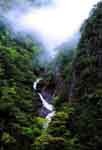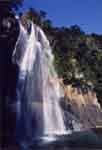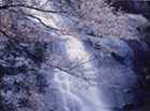Healing - Exhibits - Waterfall
- Hanajiro Waterfall
-
 The somewhat humorous name 'Hanajiro', meaning
'Whitenose Waterfall', derives from a legend regarding a
white-nosed eel which once lived at the base of this
waterfall. From Shingu it can be found by travelling
along Highway 168 to the 'Hanajirochaya Teahouse'. There
you turn left and you will come to the fall in after
about 10 minutes. The waterfall is about 80 meters high.
Standing at the foot of this waterfall with the cool and
misty air moistening your face you can forget all the
trivialities of the day..
The somewhat humorous name 'Hanajiro', meaning
'Whitenose Waterfall', derives from a legend regarding a
white-nosed eel which once lived at the base of this
waterfall. From Shingu it can be found by travelling
along Highway 168 to the 'Hanajirochaya Teahouse'. There
you turn left and you will come to the fall in after
about 10 minutes. The waterfall is about 80 meters high.
Standing at the foot of this waterfall with the cool and
misty air moistening your face you can forget all the
trivialities of the day..
to the top - Nachi Falls
-
 The Nachi Falls spring from a primeval forest
and fall straight down a cliff which is 133 meters in
height. It is said to be the most spectacular waterfall
in the Kumano area. Whoever looks up into it can feel the
tangible existence of God. The beauty and gentleness of
nature here leaves a definite and long lasting impression
in one's mind. In ancient times people felt the existence
of God in this waterfall and worshipped it as a deity.
The waterfall was considered to be a god in itself which
could not be measured by human wisdom when looking up to
see it falling down from the sky and splashing into the
pools below. Perhaps it is best described in this Waka poem: 'Three layers of waterfall/clear mind/accumulated
sins/washed and cleansed away'. Nachi Falls and the
surrounding area are imbued with a deeply spiritual
atmosphere which at once refreshes both mind and body
leaving a lasting impression never to be forgotten.
The Nachi Falls spring from a primeval forest
and fall straight down a cliff which is 133 meters in
height. It is said to be the most spectacular waterfall
in the Kumano area. Whoever looks up into it can feel the
tangible existence of God. The beauty and gentleness of
nature here leaves a definite and long lasting impression
in one's mind. In ancient times people felt the existence
of God in this waterfall and worshipped it as a deity.
The waterfall was considered to be a god in itself which
could not be measured by human wisdom when looking up to
see it falling down from the sky and splashing into the
pools below. Perhaps it is best described in this Waka poem: 'Three layers of waterfall/clear mind/accumulated
sins/washed and cleansed away'. Nachi Falls and the
surrounding area are imbued with a deeply spiritual
atmosphere which at once refreshes both mind and body
leaving a lasting impression never to be forgotten.
to the top - In-Yo (Yin-Yang) Falls
-
 This waterfall suddenly appears out of an old
growth forest. It is called Nakago Waterfall and is one
of 48 waterfalls near Nachi Falls. Yin and Yang refers to
the male and female qualities, or plus and minus as found in nature, but
free of any value judgment. Yin and Yang simply are the two main
interacting qualities of life and nature. Looking
at the picture you can see why it is called Yin-Yang
Falls. This waterfall has a beautiful pool at its base
which reflects the green of the trees around it. There
are numerous waterfalls gracing the many tributaries running into the Nachi
River on Nachi Mountain. The east tributary is called
Ootaninagare, of which the In-Yo Waterfall is furthest
downstream. Even today many monks of Mountain Buddhism
train themselves there.
This waterfall suddenly appears out of an old
growth forest. It is called Nakago Waterfall and is one
of 48 waterfalls near Nachi Falls. Yin and Yang refers to
the male and female qualities, or plus and minus as found in nature, but
free of any value judgment. Yin and Yang simply are the two main
interacting qualities of life and nature. Looking
at the picture you can see why it is called Yin-Yang
Falls. This waterfall has a beautiful pool at its base
which reflects the green of the trees around it. There
are numerous waterfalls gracing the many tributaries running into the Nachi
River on Nachi Mountain. The east tributary is called
Ootaninagare, of which the In-Yo Waterfall is furthest
downstream. Even today many monks of Mountain Buddhism
train themselves there.
to the top - Ichiya Waterfall
-
 'Ichiya
Waterfall', which means 'one night waterfall', appears
suddenly after the rain, and disappears like an illusion.
This waterfall is in the mountains in Kiwa-town. You can
witness a lot of 'Ichiya' waterfalls in Kumano, being
an area where there are a many steep rocky mountains and
a lot of rain. Most of them appear and disappear deep in
the mountains without ever being seen. You can see many
such waterfalls of various sizes on the cliffs after a
heavy rain along Highway 168 between Shingu and
Totsukawa.
'Ichiya
Waterfall', which means 'one night waterfall', appears
suddenly after the rain, and disappears like an illusion.
This waterfall is in the mountains in Kiwa-town. You can
witness a lot of 'Ichiya' waterfalls in Kumano, being
an area where there are a many steep rocky mountains and
a lot of rain. Most of them appear and disappear deep in
the mountains without ever being seen. You can see many
such waterfalls of various sizes on the cliffs after a
heavy rain along Highway 168 between Shingu and
Totsukawa.
to the top - Nunobiki Waterfall
-
 This is a famous waterfall which is
representative of the natural surroundings of Kiwa Town.
This is probably the most graceful and feminine among all
the waterfalls in the area. 'Nunobiki Waterfall' is soft
and calm and looks like silk sliding down the rocks into
the depths of the forest. In early summer the forest
paths are lush with new green, and in the fall the red
and orange hues of the trees are stunningly beautiful. As
you walk along the path you will start to hear its soft
murmur before you catch sight of the waterfall slipping
down onto the sleek rock surface. You can then just let
your mind and body melt into the pure atmosphere of the
pristine falls taking in the fragrance, the sound, and
the sights.
This is a famous waterfall which is
representative of the natural surroundings of Kiwa Town.
This is probably the most graceful and feminine among all
the waterfalls in the area. 'Nunobiki Waterfall' is soft
and calm and looks like silk sliding down the rocks into
the depths of the forest. In early summer the forest
paths are lush with new green, and in the fall the red
and orange hues of the trees are stunningly beautiful. As
you walk along the path you will start to hear its soft
murmur before you catch sight of the waterfall slipping
down onto the sleek rock surface. You can then just let
your mind and body melt into the pure atmosphere of the
pristine falls taking in the fragrance, the sound, and
the sights.
to the top - Arataki Waterfall
-
 Unlike Nunobiki Waterfall, 'Arataki Waterfall'
('rough falls') is a symbol of hardness and masculinity.
As if splitting the forest and mountain into two it flows
down incessantly, untouched by human hands. It impresses
us with its strength and power, contrary to the
gentleness of Nunobiki Waterfall. This masculine severity
is also considered an aspect of the 'healing' nature of
Kumano.
Unlike Nunobiki Waterfall, 'Arataki Waterfall'
('rough falls') is a symbol of hardness and masculinity.
As if splitting the forest and mountain into two it flows
down incessantly, untouched by human hands. It impresses
us with its strength and power, contrary to the
gentleness of Nunobiki Waterfall. This masculine severity
is also considered an aspect of the 'healing' nature of
Kumano.
to the top - The Waterfall of Ooma Shrine
-
 At the apex of the triangle made by Onigajo and
Shishiiwa along the coast is a sacred space hidden in the
mountains. Onigajo and Shisiiwa are considered guardian
spirits of this 'power spot' according to the Shinto
tradition. In the Ancient Shinto tradition shrine
buildings were unnecessary for the people to worship at
the many holy spots in Kumano. Although there is a shrine
found there today, called Ooma Shrine, in ancient times
the waterfall, the rocks, and the mountain were the
objects of worship, found just as they are in the world
of nature. This waterfall flows from the forest around
Ooma Shrine. This forest is full of broad-leaf evergreen
trees with huge cedars found in the rocky ravine. This is
a wonderful place with abundant species of plants and
trees indigenous to the area and shows what the forests
must have been like before monoculture aforestation
began in Japan. This area is also designated as a
Municipal Natural Treasure.
At the apex of the triangle made by Onigajo and
Shishiiwa along the coast is a sacred space hidden in the
mountains. Onigajo and Shisiiwa are considered guardian
spirits of this 'power spot' according to the Shinto
tradition. In the Ancient Shinto tradition shrine
buildings were unnecessary for the people to worship at
the many holy spots in Kumano. Although there is a shrine
found there today, called Ooma Shrine, in ancient times
the waterfall, the rocks, and the mountain were the
objects of worship, found just as they are in the world
of nature. This waterfall flows from the forest around
Ooma Shrine. This forest is full of broad-leaf evergreen
trees with huge cedars found in the rocky ravine. This is
a wonderful place with abundant species of plants and
trees indigenous to the area and shows what the forests
must have been like before monoculture aforestation
began in Japan. This area is also designated as a
Municipal Natural Treasure.
to the top - Kiyotaki Waterfall Waterfall of Hisetsu

-

to the top -
-
 'Ichiya
Waterfall', which means 'one night waterfall', appears
suddenly after the rain, and disappears like an illusion.
This waterfall is in the mountains in Kiwa-town. You can
witness a lot of 'Ichiya' waterfalls in Kumano, being
an area where there are a many steep rocky mountains and
a lot of rain. Most of them appear and disappear deep in
the mountains without ever being seen. You can see many
such waterfalls of various sizes on the cliffs after a
heavy rain along Highway 168 between Shingu and
Totsukawa.
'Ichiya
Waterfall', which means 'one night waterfall', appears
suddenly after the rain, and disappears like an illusion.
This waterfall is in the mountains in Kiwa-town. You can
witness a lot of 'Ichiya' waterfalls in Kumano, being
an area where there are a many steep rocky mountains and
a lot of rain. Most of them appear and disappear deep in
the mountains without ever being seen. You can see many
such waterfalls of various sizes on the cliffs after a
heavy rain along Highway 168 between Shingu and
Totsukawa. 
